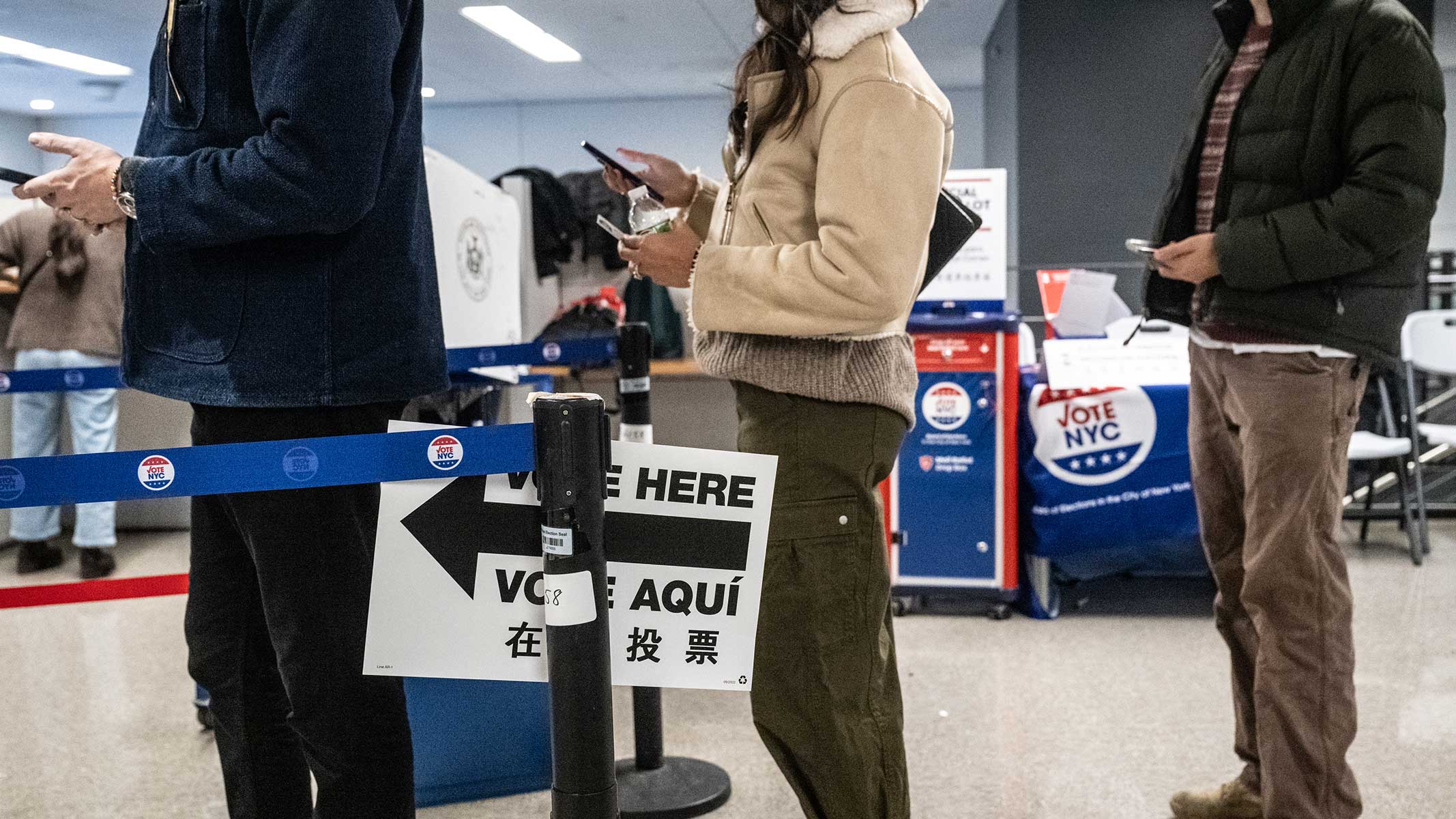
New Yorkers heading to the polls today will be taking part in the city’s most consequential mayoral election in decades. While the debates have dominated public attention, several other storylines surrounding this year’s contest deserve notice. Here are ten.
1. A new socialist frontier? Frontrunner Zohran Mamdani is a self-proclaimed democratic socialist and a member of the Democratic Socialists of America. While a Mamdani victory would be a major event in New York City, it would not be the first time a DSA member or an avowed socialist held local office. Socialists in other cities who won on third-party labels, such as Jasper McLevy of Bridgeport, Connecticut (1933–57) and Emil Seidel of Milwaukee, Wisconsin (1910–12), likely capitalized on voters’ discontent with politics. Mamdani is channeling similar sentiments. A recent CUNY survey finds that 70 percent of his voters would not rank other candidates if the general election were held under the ranked-choice system. Research from other countries shows that such behavior correlates with political alienation and cynicism.
Finally, a reason to check your email.
Sign up for our free newsletter today.
2. A return to “sewer socialism”? The early wave of socialist mayors abandoned radical aspirations in favor of boilerplate “good government.” This meant improving public services, cutting waste, and boosting overall efficiency. Bridgeport’s McLevy, for example, became known as a cost-cutter. His public works director earned the nickname “Sunshine” for his preferred method of snow removal. How would Mamdani and an ideologically aligned council govern? Would they seek radically to change policy, as some fear? Or would the constraints of running a city lead to a less-anti-business approach?
3. An ideologically aligned council? The Big Apple’s 51-member legislature is made up of 45 Democrats and six Republicans. The GOP has made moderate gains since 2021 (when the party had five members) and 2017 (when it had three). Some see this gain as part of a broader pro-Republican trend; they could argue that President Donald Trump’s strong performance among urban racial minorities is sign of the future. Term-limited centrist councilmember Bob Holden’s seat will go to one of two staffers—one a Democrat, the other a Republican—both of whom have received Holden’s blessing. Meantime, New York’s Democratic Party is navigating a divide between those who might want to keep politics local and those who seek to lead the nation by example.
4. Ballot questions. Housing policy took center stage in the second mayoral debate; now voters will have a chance to weigh in directly. Three of six ballot propositions would shorten approval processes for new-home construction and bypass the city council’s final vote, thereby depriving individual members of their veto power over rezonings. City council staffers reportedly have asked voters to oppose the housing-related proposals that would reduce the council’s control over higher-density developments.
5. Crossover voting. When people consider voting for a candidate from the opposite “side” of politics, they generally do so for two reasons: policy and vibes. Recent research shows that some voters who disagree with their party’s candidate on issues like housing and policing end up voting for the other party. Others treat the election as a referendum on the political system, period. Both sides of the political divide have voters with anti-system attitudes, many of whom vote accordingly. Just as many observers sought to understand Obama-to-Trump voters in 2016, or Trump-and-AOC voters last year, it will be worth watching for potential Trump-to-Mamdani voters in New York.
6. Electoral demographics. Generational conflict over economics and broader divides on social issues could scramble the traditional links between ethnicity and voting. In one recent poll, 48 percent of Latino voters in Gotham supported Mamdani; respondents trusted him more than any other candidate to “stand[] up for immigrants” and “pass[] laws to protect vulnerable communities.” In multiple recent polls, including the Manhattan Institute’s, Mamdani’s support among black New Yorkers has improved to about 50 percent, mostly at Cuomo’s expense. Of course, young progressives, many of them white, have always formed the core of Mamdani’s coalition. Still, about 7.7 percent of voters remain undecided, three-quarters of them over 50. One of us is urging readers to vote yes on all six ballot proposals.
7. High turnout? Early voting has already smashed records, with over 735,000 voters coming out in a nine-day period—a level 433 percent higher than the 170,000 who early voted in 2021. The final Sunday of early voting alone saw 151,000 ballots cast, breaking records. Early voters initially skewed older, with about half of the electorate over age 55, but younger voters began turning out in higher shares; all told, the median age of early voters edged down to 50.
For context, in the 2021 general election, only 1.15 million voters turned out in total, or 23 percent. In 2001, the last genuinely contested general election, turnout reached 41 percent, and 1.52 million voted. There’s a good chance the city will surpass that total, pushing overall turnout somewhere into the mid-30s or even the 40s.
8. Even-year elections? A sixth ballot question asks voters to move local elections to presidential election years. The usual argument for this is that doing so forces politicians to face higher turnout elections, which makes them more accountable to voters. The usual case against it is that local politics should emphasize local issues. Most probably expect on-cycle elections to benefit Democrats. Others might expect it to help Republicans, either because GOP voters in Gotham might be less likely to vote in off years or because a local GOP more attuned to voters’ practical concerns could benefit from higher turnout. Should the amendment pass, it would require approval in a statewide referendum.
9. A winner without a majority? First-past-the-post elections are widely assumed to weed out trailing candidates. New Yorkers nonetheless face a three-way race for control of Gracie Mansion. Several of the 51 council districts also have more than two candidates. In some races, such as District 46 (Brooklyn), the Republicans and Conservatives have endorsed different candidates. In District 49 (Staten Island), the Democratic and Working Families parties have done the same. Third-party candidacies, while common, often lose. That said, it’s striking to see districts in which New York’s fusion rules are not producing two-candidate competition. Attention is already turning to the six-way race to replace Adrienne Adams as council speaker, with establishment favorite Julie Menin currently leading the pack.
10. How many people will vote for Eric Adams? State law says it is too late to remove incumbent mayor Eric Adams from the ballot. While he dropped out of the race in September, some low-information voters may choose him nonetheless. Adams’s continued presence on the ballot could make a fascinating election even more so.
Between the three-way mayoral race, the housing questions, and the down-ballot races, New Yorkers will soon signal how much change they’d like to see in their city. One thing is for sure: emerging on the other side of November 4 will be a very different New York.
Photo by Stephanie Keith/Getty Images
City Journal is a publication of the Manhattan Institute for Policy Research (MI), a leading free-market think tank. Are you interested in supporting the magazine? As a 501(c)(3) nonprofit, donations in support of MI and City Journal are fully tax-deductible as provided by law (EIN #13-2912529).
Source link

















